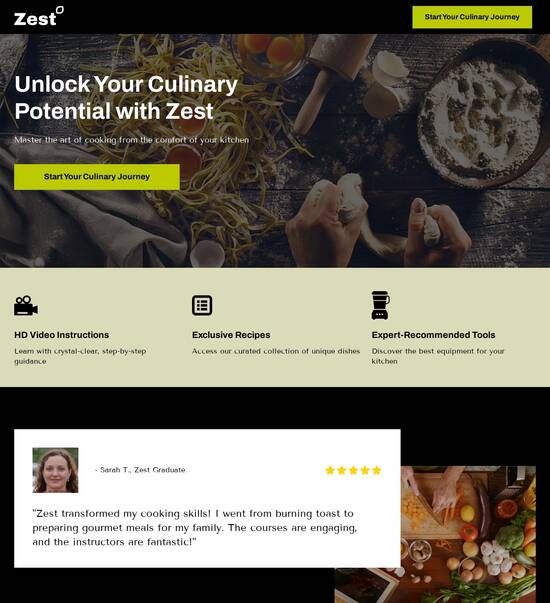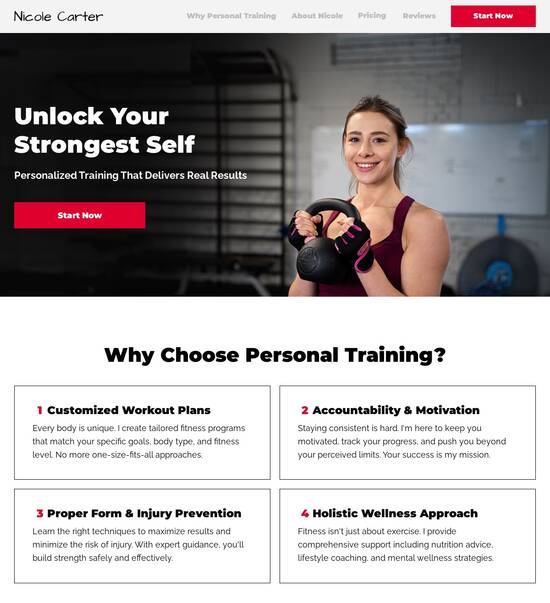
Weather forecast website template optimized for Amazon Fire tablet
Explore Similar TemplatesAbout template
Instapage weather forecast website templates look great and convert on any device, including Amazon Fire tablet. Start customizing it now!
Recommended templates

Easy to build without coding
With the intuitive drag-and-drop builder, anyone on your team can create high-converting pages without any knowledge of code or design. Make enhancements to your landing page with custom widgets using Javascript, HTML/CSS, or third-party scripts.

Multiple layouts for any industry and goal
Select from 500+ landing page layouts built to boost conversions across industry-specific scenarios. Customize them by adjusting fonts, adding images, and generating on-brand content with the AI assistant. Quickly scale with Instablocks® and Global Blocks that you can save, reuse, and update globally.

Loads fast and looks polished on any device
Every template is responsive, which means they present professionally on any device and load blazingly fast with our Thor Render Engine. You can also power them up with Google AMP technology to deliver an unparalleled mobile experience and drive higher conversions.

Robust analytics & experimentation
Get real-time updates and reporting across all your devices, showing the number of visitors, conversions, cost-per-visitor, and cost-per-lead. Launch AI-powered experiments, run A/B tests, and use heatmaps to analyze user behavior, then optimize your landing page to maximize conversions.







Easy to build without coding
With the intuitive drag-and-drop builder, anyone on your team can create high-converting pages without any knowledge of code or design. Make enhancements to your landing page with custom widgets using Javascript, HTML/CSS, or third-party scripts.
Multiple layouts for any industry and goal
Select from 500+ landing page layouts built to boost conversions across industry-specific scenarios. Customize them by adjusting fonts, adding images, and generating on-brand content with the AI assistant. Quickly scale with Instablocks® and Global Blocks that you can save, reuse, and update globally.
Loads fast and looks polished on any device
Every template is responsive, which means they present professionally on any device and load blazingly fast with our Thor Render Engine.
Robust analytics & experimentation
Get real-time updates and reporting across all your devices, showing the number of visitors, conversions, cost-per-visitor, and cost-per-lead. Launch AI-powered experiments, run A/B tests, and use heatmaps to analyze user behavior, then optimize your landing page to maximize conversions.
All the features you need to build lead-generating landing pages
Explore more featuresLearn how to build top-performing landing pages for any goal
FAQs
Leading the way in building high-performing landing pages





Maximizing ROI with Instapage: The Ultimate Guide to Landing Page Optimization
Harnessing the power of Instapage can transform your digital marketing strategies, especially in complex industries like financial services and tech. With its robust landing page customization features, you can capitalize on high-converting templates, ensuring every campaign delivers solid ROI. This comprehensive guide walks you through the essential steps to optimize landing pages tailored specifically for marketers across various sectors in the USA.
Why Landing Page Optimization is Crucial
Effective landing page optimization is pivotal in nurturing leads through the sales funnel. It ensures that potential customers experience seamless navigation, compelling calls to action, and personalized content that resonates with their needs. Utilizing Instapage allows marketers to create visually appealing and conversion-driven pages without extensive coding knowledge.
- Increases Conversion Rates: Optimized landing pages can double or even triple your conversion rates, allowing you to maximize returns on your marketing investments.
- Enhances Brand Credibility: Well-designed pages improve user trust, making it more likely they will engage with your content.
- Reduces Bounce Rates: Engaging designs tailored for target audiences can significantly lower bounce rates, keeping visitors on your site longer.
Getting Started with Instapage
The first step in leveraging Instapage for your campaigns is to explore its vast library of templates. With over 100 high-converting options, finding a layout that aligns with your brand is simple. Here's how to kick off your setup.
- Choose a Template: Browse the library of conversion-focused layouts to find a suitable design.
- Customize Your Page: Use the intuitive drag-and-drop builder to add your branding elements and modify content to appeal to your unique audience.
- Publish and Test: Launch your landing page and use built-in A/B testing features to refine elements based on performance data.
Optimizing for Higher Conversions
Once your landing page is live, the next essential step is optimization. Instapage's built-in experimentation features help refine your approach effectively. To achieve maximum conversions, consider implementing these strategies.
- Use Heatmaps: Analyze user behavior with detailed heatmaps to identify where visitors are clicking or losing interest.
- Conduct A/B Testing: Regularly test different variations of headlines, calls-to-action, and images to see what resonates best with your audience.
- Integrate Analytics: Utilize the analytics dashboard to monitor performance metrics and make data-driven adjustments as needed.
These steps will not only enhance the user experience but also significantly impact your conversion rates and overall campaign success.
By following this guide, marketers in sectors such as education, government, and energy will discover the full potential of Instapage to elevate their digital marketing efforts.
Ready to transform your landing pages and maximize ROI? Start using Instapage today and join a community that is committed to success!
People also ask about Weather forecast website template optimized for Amazon Fire tablet
Weather forecast website template optimized for Amazon Fire Tablet
Overview of weather forecast websites
Weather forecasting plays a pivotal role in our daily routines. From planning outdoor activities to preparing for storms, knowing what to expect from the weather allows individuals and communities to make informed decisions. Access to accurate forecasts is especially crucial for professions like agriculture, construction, and emergency services where environmental conditions can heavily influence outcomes.
In recent years, trends in weather forecasting solutions have evolved notably, with the incorporation of advanced technology and data analytics. Many providers are transitioning to more interactive and engaging platforms that prioritize user experience. This shift is driven by the necessity to deliver real-time updates and in-depth analyses, which significantly enhance the user's ability to respond to changing conditions.
As more individuals rely on mobile devices for information retrieval, the significance of optimizing websites for tablets, such as Amazon Fire Tablets, becomes increasingly apparent. A mobile-optimized weather forecast website ensures accessibility, better viewing experiences, and device-specific features that enhance user engagement.
Exploring weather forecast website templates
Website templates serve as foundational structures for creating engaging and functional online platforms. They provide a categorized layout and pre-designed components that can be tailored to fit specific needs, significantly speeding up the web development process. For weather forecasting, these templates are specialized to display crucial data effectively.
Utilizing templates for weather forecast websites comes with a plethora of benefits. First and foremost, they save time by providing users with convenient, ready-to-use layouts. This can be particularly useful for small businesses and startups that may lack the web development resources to build from scratch. Moreover, templates ensure a consistent user experience across various pages, making navigation straightforward.
Time-saving design solutions: Users can quickly get online without extensive coding knowledge.
Consistency in user experience: Pre-designed components ensure uniform design throughout the site.
Easy updates and modifications: Templates make it simple to change elements as required.
Different types of weather forecast website templates exist to cater to a variety of user needs. Options include free versus premium selections, allowing for flexibility depending on budget. Custom templates offer unique designs tailored to specific branding, while pre-built templates provide ready-to-use content. When selecting a template, prioritizing responsive designs is critical, particularly for users accessing the site via an Amazon Fire Tablet.
Features and capabilities of a weather forecast website template
An intuitive layout is essential for weather forecast websites to ensure users can access information effortlessly, especially on Amazon Fire Tablets. Navigation menus should be straightforward and user-friendly, allowing for easy transitions between different weather conditions and alerts. The importance of a mobile-first design cannot be overstated; it directly influences how information is presented on smaller screens.
Critical to any weather forecast website is the incorporation of essential widgets, which serve various functions to enhance the user experience. These include displaying current weather conditions, showcasing interactive radar and maps, offering hourly and weekly forecasts, and customizable alert notifications. Such widgets keep users informed and engaged, helping them find the exact data they need quickly.
Current weather conditions display: Users get immediate insights into local weather.
Interactive radar and map widgets: Visualize weather patterns in real-time.
Hourly and weekly forecasts: Comprehensive data for users planning ahead.
Customizable alerts and notifications: Users can receive specific updates relevant to them.
Themes also play a crucial role in enhancing the user experience on weather websites. Choosing appropriate color schemes can reflect weather conditions—think blues for clear skies, grays for cloudy forecasts, and reds for severe weather alerts. Seasonal themes can dynamically adjust the interface based on current conditions, making it visually engaging while also improving content relevance. Furthermore, accessibility considerations should inform how these themes are selected and implemented.
Building a rich content experience
To create a truly engaging weather forecast website, integrating multimedia elements can significantly enhance the content experience. Incorporating videos that showcase changing weather patterns or photo galleries featuring local weather events adds a dynamic layer of interaction. Infographics explaining complex weather phenomena can also serve to educate users while keeping their interest piqued.
Providing valuable resources is another cornerstone of a successful weather forecast website. This can include downloadable local and national forecast reports, which add depth to the information provided. Educating users about weather safety tips increases the site's value while hosting community forums creates a space for discussion around weather topics, fostering engagement among users.
Downloadable local and national forecast reports: Users have access to comprehensive weather data.
Educational content on weather safety tips: Helping users prepare for various weather scenarios.
Community forums for weather discussions: Fostering user interaction and shared insights.
To ensure the information shared is reliable, it is crucial to pull content from trustworthy sources such as established meteorological services. Utilizing real-time data and API integration can facilitate up-to-date weather reports. Additionally, leveraging crowdsourced information enables localized updates, which can be especially valuable for smaller communities.
User engagement and interaction
Boosting user engagement on a weather forecast website requires creating interactive elements that capture interest. For instance, user-activated weather predictions enable visitors to customize their forecasts based on their preferences or locations. Quizzes and polls about weather knowledge can also encourage users to participate, making them feel invested in their experience.
Social media integration is another critical aspect for sharing weather updates. Features that allow users to easily share real-time weather information on their favorite social platforms can drive traffic back to the website. Additionally, creating sections for user-generated content and testimonials fosters a sense of community and interaction among users, encouraging repeat visits.
User-activated weather predictions: Customizations lead to heightened user interest.
Polls and quizzes related to weather knowledge: Encourage participation and sharing.
Utilizing click metrics emerges as a vital method for website optimization. Analyzing user interactions helps identify which sections engage users most effectively. Assessing click-through rates and engagement statistics further allows for refining the site to align better with user preferences.
Download and customization options
When it comes to implementing a weather forecast website template, a variety of downloadable resources are available. Template kits geared towards beginners facilitate a smoother setup process, while advanced options cater to experienced developers craving more freedom for custom designs. This versatility ensures that all users find the appropriate resources to meet their design and functionality needs.
A modular approach to customization allows users to build personalized widgets and features easily. This method enables sites to adapt templates to align with unique brand identities without excessive overhead or restructuring. It encourages creativity while maintaining essential functionality.
Template kits for beginners: Simplifies launching a website.
Advanced options for experienced developers: Allows for in-depth customization.
For those unfamiliar with web development, training videos and tutorials offer significant guidance. Step-by-step guides can simplify template setup, while advanced tutorials demonstrate how to harness powerful features for maximum impact. Such support empowers users to fully utilize the potential of their weather forecast website.
Navigating the market for weather forecast templates
Enthusiasts looking for weather forecast website templates should explore the market landscape for popular providers and offerings. Conducting a thorough comparison of features and pricing models will greatly assist in determining which templates best align with specific needs. Best practices include looking for templates that cater to both functionality and attractive design.
User reviews and feedback are invaluable when assessing potential templates. By understanding the experiences of others, users can glean insights into the performance, reliability, and overall satisfaction associated with different products. Interpreting user ratings effectively can reveal strengths and weaknesses that may not be immediately obvious through marketing materials.
Comparison of features and pricing models: Essential for cost-effectiveness.
Importance of community feedback in template selection: Cultivates informed decisions.
Finally, future trends in weather forecasting websites hint at technology integration expansions and innovations surging toward improved user engagement. Staying ahead by forecasting these industry shifts will help developers and businesses remain competitive in a rapidly changing digital landscape.
Best practices for optimizing weather forecast websites
Optimizing a weather forecast website for mobile devices necessitates focusing on fast loading times. Techniques such as compressing images and resources can significantly improve performance. Additionally, minimizing the use of heavy scripts and unnecessary plugins helps streamline operations, resulting in quicker access to weather information.
Search engine optimization (SEO) considerations also play a crucial role in the visibility and success of a weather forecast website. Integrating relevant keywords related to local weather throughout the content allows for better organic reach. A targeted SEO strategy can substantially increase traffic and user engagement, providing a pathway for growth.
Compression of images and resources: Enhances loading speeds.
Minimizing heavy scripts and unnecessary plugins: Streamlines site performance.
Continuous adaptation to user needs is fundamental for long-term success. Monitoring weather events and updates allows content to remain relevant and timely. Engaging with user feedback also provides insights into preferences and expectations, ensuring that the website evolves in line with audience desires.
Conclusion: The future of weather forecast websites on Amazon Fire Tablets
As the landscape of weather forecasting evolves, web developers must remain agile, integrating new technologies and meeting user demands. Optimizing weather forecast websites for devices like Amazon Fire Tablets not only caters to user preferences but also broadens reach and impact. The future lies in continued innovation and responsiveness to trends, ensuring that both developers and users benefit from enhanced forecasting experiences.
Ultimately, maintaining an accurate understanding of the digital landscape and the importance of creating user-friendly experiences will drive success in the realm of weather forecasting websites. By leveraging templates specifically optimized for mobile interactions, users can efficiently navigate and engage with valuable weather information.
Ready to skyrocket conversions?
Supercharge your ad campaigns with high-performing landing pages
Get started














